Approaches to Leadership and Management in a Global Context Report
VerifiedAdded on 2021/01/02
|9
|2624
|320
Report
AI Summary
This report examines leadership and management strategies within the context of Rowlinson Knitwear, a UK-based medium-sized company. It begins by outlining the functional areas of the business and the management hierarchy, including operational, middle, and top management levels. The report emphasizes the importance of effective communication for both leadership and management, providing examples of interdepartmental communication. It then explores the current drivers of globalization, such as technological, political, market, cost, and competitive drivers, and their impact on business operations. Furthermore, the report compares and contrasts autocratic and democratic leadership styles, ultimately recommending democratic leadership as the most appropriate approach for Rowlinson Knitwear. The analysis highlights how this style can foster employee engagement and satisfaction. The report concludes by summarizing the key findings and recommendations.
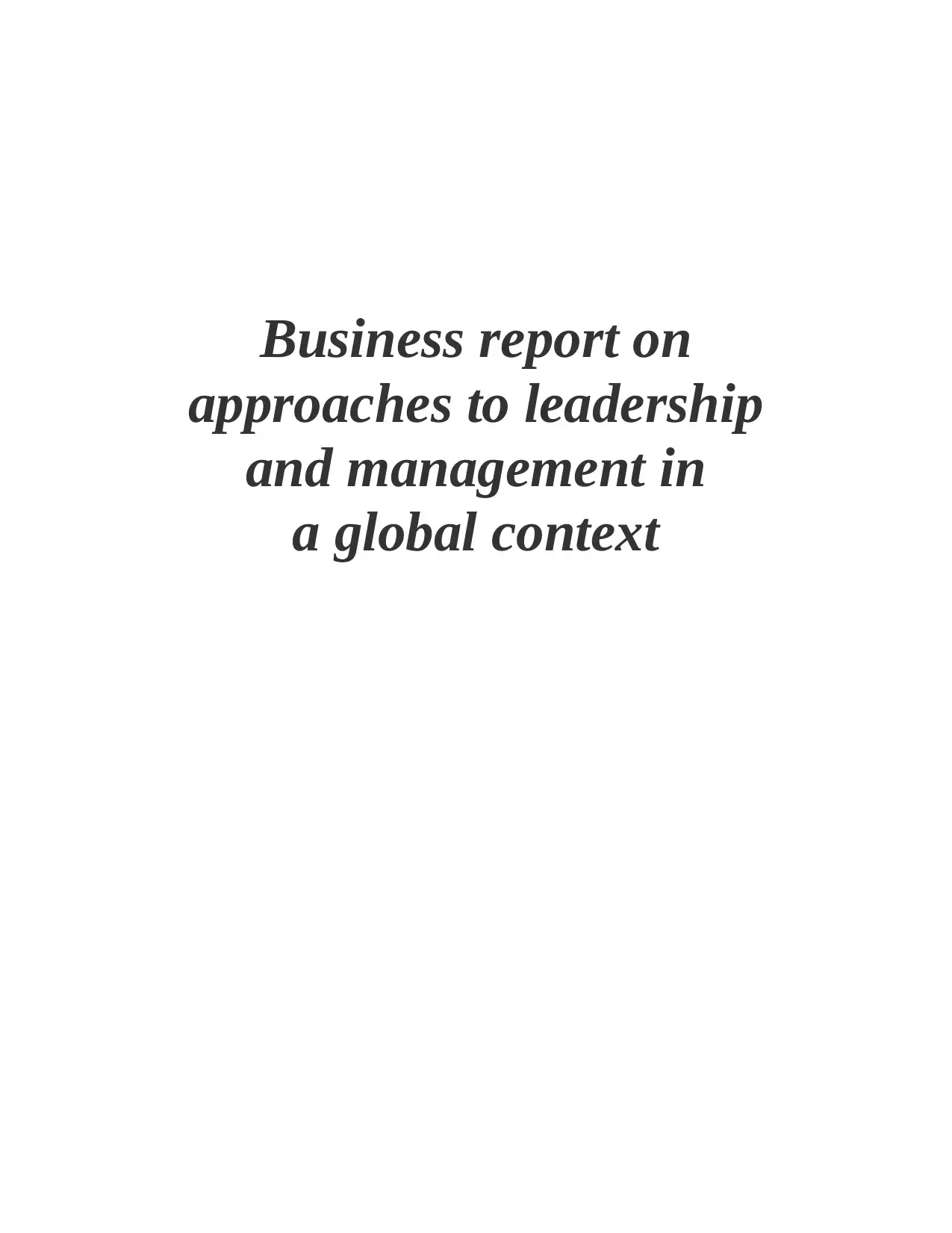
Business report on
approaches to leadership
and management in
a global context
approaches to leadership
and management in
a global context
Paraphrase This Document
Need a fresh take? Get an instant paraphrase of this document with our AI Paraphraser
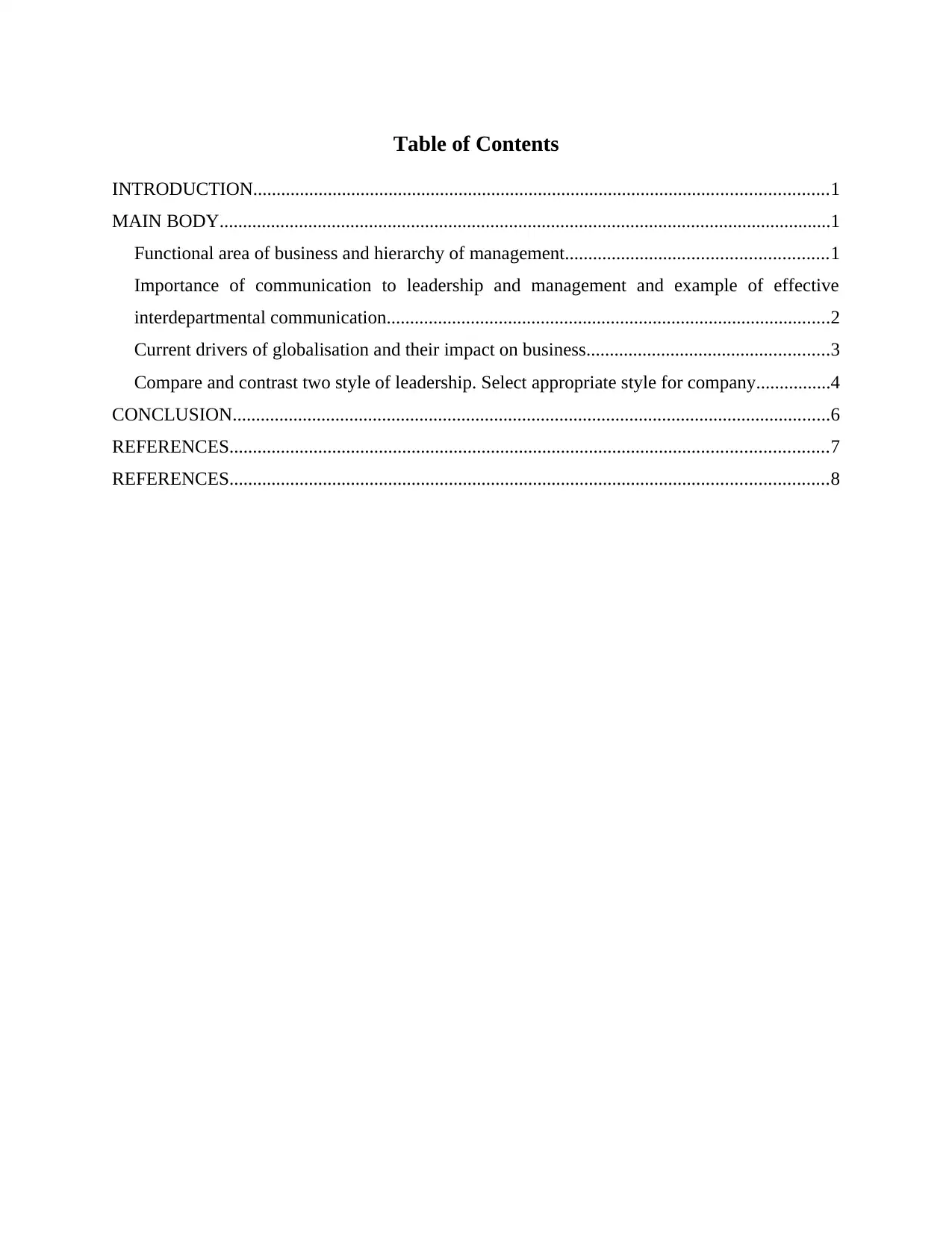
Table of Contents
INTRODUCTION...........................................................................................................................1
MAIN BODY...................................................................................................................................1
Functional area of business and hierarchy of management........................................................1
Importance of communication to leadership and management and example of effective
interdepartmental communication...............................................................................................2
Current drivers of globalisation and their impact on business....................................................3
Compare and contrast two style of leadership. Select appropriate style for company................4
CONCLUSION................................................................................................................................6
REFERENCES................................................................................................................................7
REFERENCES................................................................................................................................8
INTRODUCTION...........................................................................................................................1
MAIN BODY...................................................................................................................................1
Functional area of business and hierarchy of management........................................................1
Importance of communication to leadership and management and example of effective
interdepartmental communication...............................................................................................2
Current drivers of globalisation and their impact on business....................................................3
Compare and contrast two style of leadership. Select appropriate style for company................4
CONCLUSION................................................................................................................................6
REFERENCES................................................................................................................................7
REFERENCES................................................................................................................................8
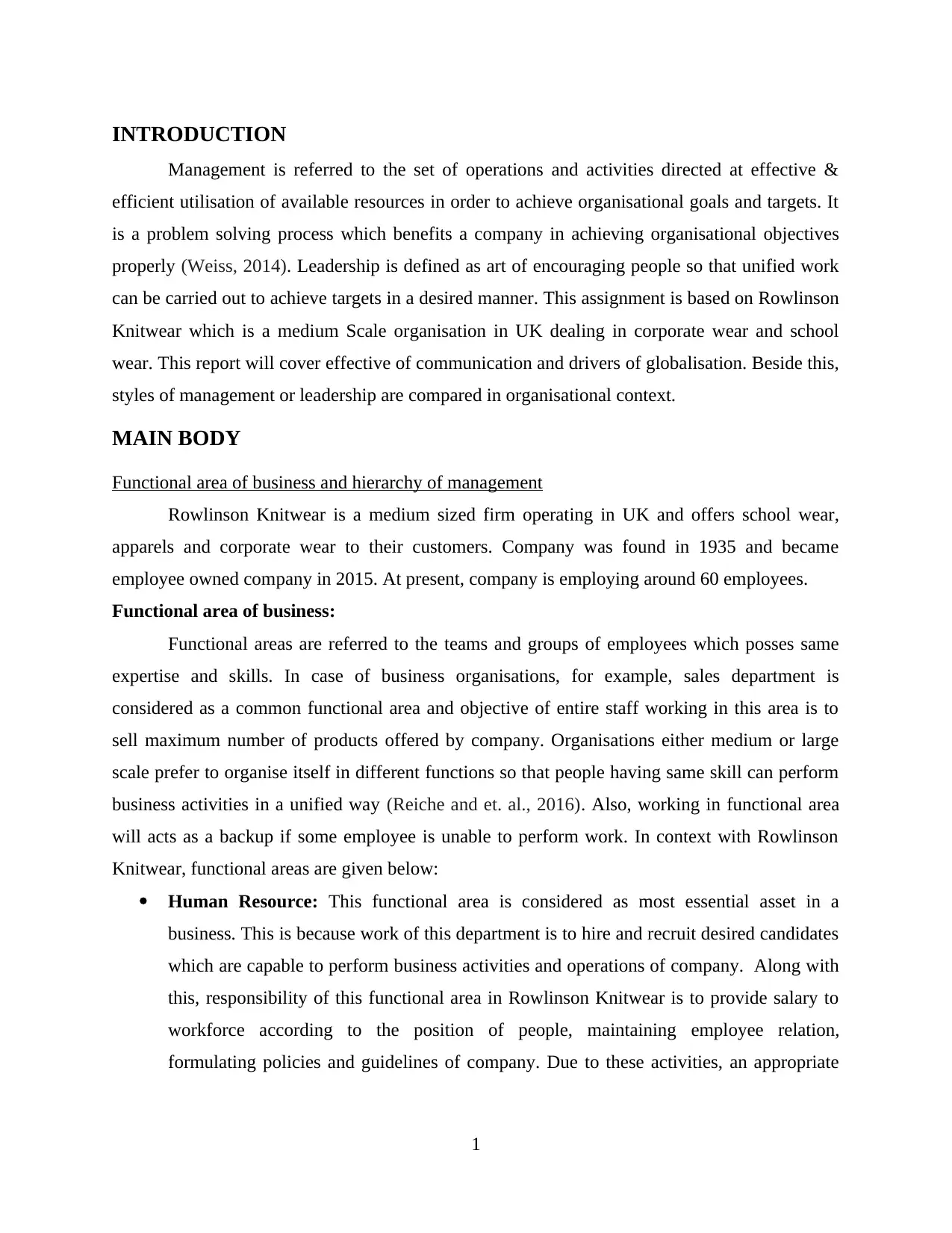
INTRODUCTION
Management is referred to the set of operations and activities directed at effective &
efficient utilisation of available resources in order to achieve organisational goals and targets. It
is a problem solving process which benefits a company in achieving organisational objectives
properly (Weiss, 2014). Leadership is defined as art of encouraging people so that unified work
can be carried out to achieve targets in a desired manner. This assignment is based on Rowlinson
Knitwear which is a medium Scale organisation in UK dealing in corporate wear and school
wear. This report will cover effective of communication and drivers of globalisation. Beside this,
styles of management or leadership are compared in organisational context.
MAIN BODY
Functional area of business and hierarchy of management
Rowlinson Knitwear is a medium sized firm operating in UK and offers school wear,
apparels and corporate wear to their customers. Company was found in 1935 and became
employee owned company in 2015. At present, company is employing around 60 employees.
Functional area of business:
Functional areas are referred to the teams and groups of employees which posses same
expertise and skills. In case of business organisations, for example, sales department is
considered as a common functional area and objective of entire staff working in this area is to
sell maximum number of products offered by company. Organisations either medium or large
scale prefer to organise itself in different functions so that people having same skill can perform
business activities in a unified way (Reiche and et. al., 2016). Also, working in functional area
will acts as a backup if some employee is unable to perform work. In context with Rowlinson
Knitwear, functional areas are given below:
Human Resource: This functional area is considered as most essential asset in a
business. This is because work of this department is to hire and recruit desired candidates
which are capable to perform business activities and operations of company. Along with
this, responsibility of this functional area in Rowlinson Knitwear is to provide salary to
workforce according to the position of people, maintaining employee relation,
formulating policies and guidelines of company. Due to these activities, an appropriate
1
Management is referred to the set of operations and activities directed at effective &
efficient utilisation of available resources in order to achieve organisational goals and targets. It
is a problem solving process which benefits a company in achieving organisational objectives
properly (Weiss, 2014). Leadership is defined as art of encouraging people so that unified work
can be carried out to achieve targets in a desired manner. This assignment is based on Rowlinson
Knitwear which is a medium Scale organisation in UK dealing in corporate wear and school
wear. This report will cover effective of communication and drivers of globalisation. Beside this,
styles of management or leadership are compared in organisational context.
MAIN BODY
Functional area of business and hierarchy of management
Rowlinson Knitwear is a medium sized firm operating in UK and offers school wear,
apparels and corporate wear to their customers. Company was found in 1935 and became
employee owned company in 2015. At present, company is employing around 60 employees.
Functional area of business:
Functional areas are referred to the teams and groups of employees which posses same
expertise and skills. In case of business organisations, for example, sales department is
considered as a common functional area and objective of entire staff working in this area is to
sell maximum number of products offered by company. Organisations either medium or large
scale prefer to organise itself in different functions so that people having same skill can perform
business activities in a unified way (Reiche and et. al., 2016). Also, working in functional area
will acts as a backup if some employee is unable to perform work. In context with Rowlinson
Knitwear, functional areas are given below:
Human Resource: This functional area is considered as most essential asset in a
business. This is because work of this department is to hire and recruit desired candidates
which are capable to perform business activities and operations of company. Along with
this, responsibility of this functional area in Rowlinson Knitwear is to provide salary to
workforce according to the position of people, maintaining employee relation,
formulating policies and guidelines of company. Due to these activities, an appropriate
1
⊘ This is a preview!⊘
Do you want full access?
Subscribe today to unlock all pages.

Trusted by 1+ million students worldwide

working culture can be formulated in company due to which employee will be able to
deliver best performance.
Marketing and sales: This functional areas are related with advertising, sales and
promotional activities so that target customers of Rowlinon Knitwear can be
acknowledged about their products or services in a proper manner. Functions of
marketing unit is to formulate different market strategies and promotional campaign
plans so that advantage over rivals can be achieved. Sales unit is given the duty to assure
that sales of service or product will results in high profitability for company (Boshyk,
2016).
Accounting and Finance: This functional unit of company manages all the financial
transactions, funds and budget of the company. Responsibility of this department is to
manage accounts, audit, organise and plan finances of Rowlinson Knitwear. Other work
of this functional area is to manage cash inflow and outflow so that company do not have
to face any problem due to shortage of funds.
Management Hierarchy:
Management hierarchy is defined as a structure for business management created by
organisations so that work potential of overall company can be improved. In context with
Rowlinson Knitwear, levels of business management hierarchy is defined below:
Operational level: It is the foremost and lowest management level in Rowlinson
Knitwear. It includes front line work along with decision making of structured nature.
Workforce of Rowlinson Knitwear perform at this level.
Middle management level: Employees working at operational level are guided at middle
management level. This level includes senior employees and managers that will direct
subordinate workforce so that high financial results can be attained (Abeysekera, 2013).
Top management level: This level is at top of hierarchical arrangement. It will include
CEO, general and managing director, president and trusties of Rowlinson Knitwear. Their
work is to plan for business and oversees the work and performance of workforce.
Importance of communication to leadership and management and example of effective
interdepartmental communication
Breakdowns in appropriate communication can acts as a major issue for leaders and
managers. Communication failure can results in heavy revenue loss for business organisations.
2
deliver best performance.
Marketing and sales: This functional areas are related with advertising, sales and
promotional activities so that target customers of Rowlinon Knitwear can be
acknowledged about their products or services in a proper manner. Functions of
marketing unit is to formulate different market strategies and promotional campaign
plans so that advantage over rivals can be achieved. Sales unit is given the duty to assure
that sales of service or product will results in high profitability for company (Boshyk,
2016).
Accounting and Finance: This functional unit of company manages all the financial
transactions, funds and budget of the company. Responsibility of this department is to
manage accounts, audit, organise and plan finances of Rowlinson Knitwear. Other work
of this functional area is to manage cash inflow and outflow so that company do not have
to face any problem due to shortage of funds.
Management Hierarchy:
Management hierarchy is defined as a structure for business management created by
organisations so that work potential of overall company can be improved. In context with
Rowlinson Knitwear, levels of business management hierarchy is defined below:
Operational level: It is the foremost and lowest management level in Rowlinson
Knitwear. It includes front line work along with decision making of structured nature.
Workforce of Rowlinson Knitwear perform at this level.
Middle management level: Employees working at operational level are guided at middle
management level. This level includes senior employees and managers that will direct
subordinate workforce so that high financial results can be attained (Abeysekera, 2013).
Top management level: This level is at top of hierarchical arrangement. It will include
CEO, general and managing director, president and trusties of Rowlinson Knitwear. Their
work is to plan for business and oversees the work and performance of workforce.
Importance of communication to leadership and management and example of effective
interdepartmental communication
Breakdowns in appropriate communication can acts as a major issue for leaders and
managers. Communication failure can results in heavy revenue loss for business organisations.
2
Paraphrase This Document
Need a fresh take? Get an instant paraphrase of this document with our AI Paraphraser
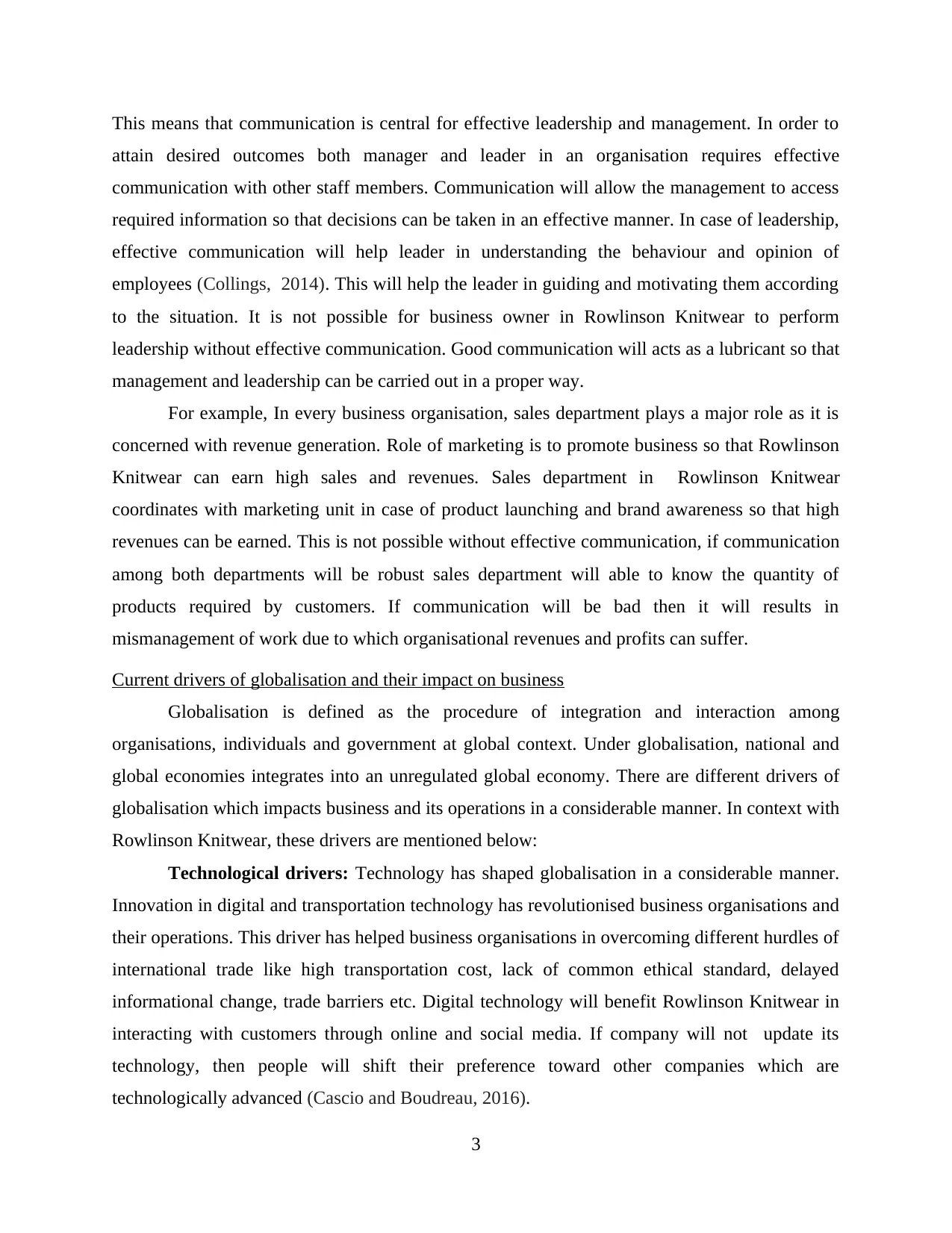
This means that communication is central for effective leadership and management. In order to
attain desired outcomes both manager and leader in an organisation requires effective
communication with other staff members. Communication will allow the management to access
required information so that decisions can be taken in an effective manner. In case of leadership,
effective communication will help leader in understanding the behaviour and opinion of
employees (Collings, 2014). This will help the leader in guiding and motivating them according
to the situation. It is not possible for business owner in Rowlinson Knitwear to perform
leadership without effective communication. Good communication will acts as a lubricant so that
management and leadership can be carried out in a proper way.
For example, In every business organisation, sales department plays a major role as it is
concerned with revenue generation. Role of marketing is to promote business so that Rowlinson
Knitwear can earn high sales and revenues. Sales department in Rowlinson Knitwear
coordinates with marketing unit in case of product launching and brand awareness so that high
revenues can be earned. This is not possible without effective communication, if communication
among both departments will be robust sales department will able to know the quantity of
products required by customers. If communication will be bad then it will results in
mismanagement of work due to which organisational revenues and profits can suffer.
Current drivers of globalisation and their impact on business
Globalisation is defined as the procedure of integration and interaction among
organisations, individuals and government at global context. Under globalisation, national and
global economies integrates into an unregulated global economy. There are different drivers of
globalisation which impacts business and its operations in a considerable manner. In context with
Rowlinson Knitwear, these drivers are mentioned below:
Technological drivers: Technology has shaped globalisation in a considerable manner.
Innovation in digital and transportation technology has revolutionised business organisations and
their operations. This driver has helped business organisations in overcoming different hurdles of
international trade like high transportation cost, lack of common ethical standard, delayed
informational change, trade barriers etc. Digital technology will benefit Rowlinson Knitwear in
interacting with customers through online and social media. If company will not update its
technology, then people will shift their preference toward other companies which are
technologically advanced (Cascio and Boudreau, 2016).
3
attain desired outcomes both manager and leader in an organisation requires effective
communication with other staff members. Communication will allow the management to access
required information so that decisions can be taken in an effective manner. In case of leadership,
effective communication will help leader in understanding the behaviour and opinion of
employees (Collings, 2014). This will help the leader in guiding and motivating them according
to the situation. It is not possible for business owner in Rowlinson Knitwear to perform
leadership without effective communication. Good communication will acts as a lubricant so that
management and leadership can be carried out in a proper way.
For example, In every business organisation, sales department plays a major role as it is
concerned with revenue generation. Role of marketing is to promote business so that Rowlinson
Knitwear can earn high sales and revenues. Sales department in Rowlinson Knitwear
coordinates with marketing unit in case of product launching and brand awareness so that high
revenues can be earned. This is not possible without effective communication, if communication
among both departments will be robust sales department will able to know the quantity of
products required by customers. If communication will be bad then it will results in
mismanagement of work due to which organisational revenues and profits can suffer.
Current drivers of globalisation and their impact on business
Globalisation is defined as the procedure of integration and interaction among
organisations, individuals and government at global context. Under globalisation, national and
global economies integrates into an unregulated global economy. There are different drivers of
globalisation which impacts business and its operations in a considerable manner. In context with
Rowlinson Knitwear, these drivers are mentioned below:
Technological drivers: Technology has shaped globalisation in a considerable manner.
Innovation in digital and transportation technology has revolutionised business organisations and
their operations. This driver has helped business organisations in overcoming different hurdles of
international trade like high transportation cost, lack of common ethical standard, delayed
informational change, trade barriers etc. Digital technology will benefit Rowlinson Knitwear in
interacting with customers through online and social media. If company will not update its
technology, then people will shift their preference toward other companies which are
technologically advanced (Cascio and Boudreau, 2016).
3

Political drivers: This driver is related with deregulated market and liberalised trading
rules. These aspects leads toward lower tariffs and encourage foreign direct investment at global
level which impacts businesses in a positive manner. Increased globalisation in business market,
reduced trade barriers and global alliances of different organisations will help Rowlinson
Knitwear to enjoy advantages due to national regulations. Political drivers of globalisation also
include investment policies and unrestricted trade, if these factors will not be in favour of
business firms, they will not be able to perform at global level in a proper way.
Market drivers: These are related with enhanced similarity in preference and taste of
customers from different markets. This driver of globalisation considerably depends upon
consumer behaviour and the structure associated with distribution networks. As regional market
is becoming saturated, opportunities associated with profitability and growth for business
organisations is very less (Fonseca, McAllister and Fitzpatrick, 2014). With the help of
marketing strategies and channels, Rowlinson knitwear can enhance its business operations at
global level due to which company will enjoy high revenues.
Cost drivers: Globalisation of consumer needs and opportunities for standardisation &
scale can impact the economies of different businesses in a considerable manner. This driver
states that a single market is not able to support a competitive strategy on a wide global scale.
Main cost driver of globalisation is sourcing costs and efficiency which varies from one nation to
another and this can impacts business organisations in a positive manner. Other cost driver is
high product development cost, if Rowlinson Knitwear will not manage cost of its product, then
customer will not prefer to buy it and shift their preference towards other economic products.
Competitive drivers: Globalisation is also impacted by competition drivers. Companies
operating at global level are required to introduce, distribute and upgrade new products at a faster
rate than their competitors so that competitive advantage can be gained. If business organisations
will not give customers the required products in a timely manner, they will purchase same
product from other rival company. This can reduce the sales of Rowlinson due to which
company can face low revenues and profitability (Jenkins and Delbridge, 2013).
Compare and contrast two style of leadership. Select appropriate style for company
Leadership style is the way through which an individual uses power guide and lead other
people in a proper manner. There are different leadership styles that can be adopted in an
organisation as per the requirements. For example, there are some leaders which are not able to
4
rules. These aspects leads toward lower tariffs and encourage foreign direct investment at global
level which impacts businesses in a positive manner. Increased globalisation in business market,
reduced trade barriers and global alliances of different organisations will help Rowlinson
Knitwear to enjoy advantages due to national regulations. Political drivers of globalisation also
include investment policies and unrestricted trade, if these factors will not be in favour of
business firms, they will not be able to perform at global level in a proper way.
Market drivers: These are related with enhanced similarity in preference and taste of
customers from different markets. This driver of globalisation considerably depends upon
consumer behaviour and the structure associated with distribution networks. As regional market
is becoming saturated, opportunities associated with profitability and growth for business
organisations is very less (Fonseca, McAllister and Fitzpatrick, 2014). With the help of
marketing strategies and channels, Rowlinson knitwear can enhance its business operations at
global level due to which company will enjoy high revenues.
Cost drivers: Globalisation of consumer needs and opportunities for standardisation &
scale can impact the economies of different businesses in a considerable manner. This driver
states that a single market is not able to support a competitive strategy on a wide global scale.
Main cost driver of globalisation is sourcing costs and efficiency which varies from one nation to
another and this can impacts business organisations in a positive manner. Other cost driver is
high product development cost, if Rowlinson Knitwear will not manage cost of its product, then
customer will not prefer to buy it and shift their preference towards other economic products.
Competitive drivers: Globalisation is also impacted by competition drivers. Companies
operating at global level are required to introduce, distribute and upgrade new products at a faster
rate than their competitors so that competitive advantage can be gained. If business organisations
will not give customers the required products in a timely manner, they will purchase same
product from other rival company. This can reduce the sales of Rowlinson due to which
company can face low revenues and profitability (Jenkins and Delbridge, 2013).
Compare and contrast two style of leadership. Select appropriate style for company
Leadership style is the way through which an individual uses power guide and lead other
people in a proper manner. There are different leadership styles that can be adopted in an
organisation as per the requirements. For example, there are some leaders which are not able to
4
⊘ This is a preview!⊘
Do you want full access?
Subscribe today to unlock all pages.

Trusted by 1+ million students worldwide
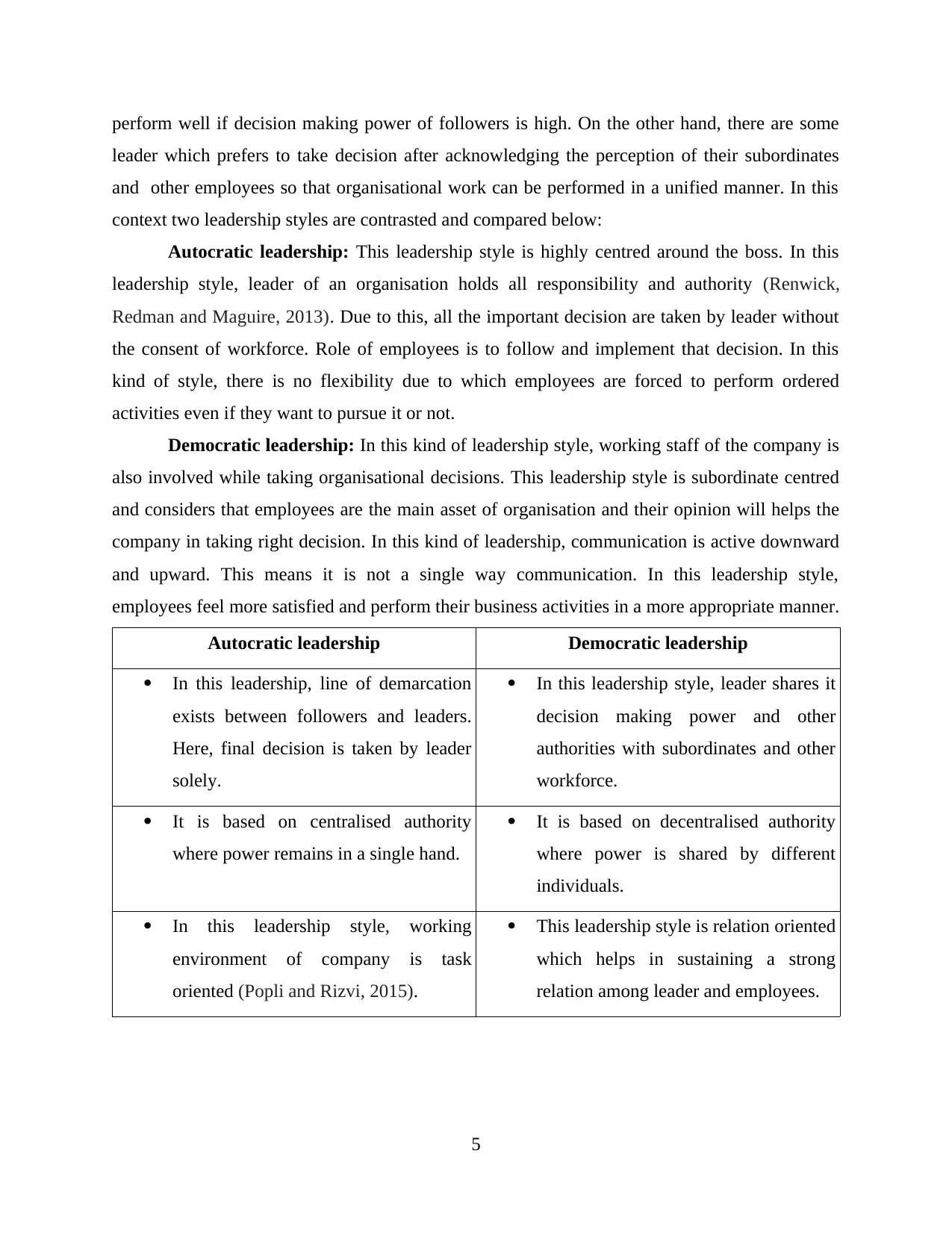
perform well if decision making power of followers is high. On the other hand, there are some
leader which prefers to take decision after acknowledging the perception of their subordinates
and other employees so that organisational work can be performed in a unified manner. In this
context two leadership styles are contrasted and compared below:
Autocratic leadership: This leadership style is highly centred around the boss. In this
leadership style, leader of an organisation holds all responsibility and authority (Renwick,
Redman and Maguire, 2013). Due to this, all the important decision are taken by leader without
the consent of workforce. Role of employees is to follow and implement that decision. In this
kind of style, there is no flexibility due to which employees are forced to perform ordered
activities even if they want to pursue it or not.
Democratic leadership: In this kind of leadership style, working staff of the company is
also involved while taking organisational decisions. This leadership style is subordinate centred
and considers that employees are the main asset of organisation and their opinion will helps the
company in taking right decision. In this kind of leadership, communication is active downward
and upward. This means it is not a single way communication. In this leadership style,
employees feel more satisfied and perform their business activities in a more appropriate manner.
Autocratic leadership Democratic leadership
In this leadership, line of demarcation
exists between followers and leaders.
Here, final decision is taken by leader
solely.
In this leadership style, leader shares it
decision making power and other
authorities with subordinates and other
workforce.
It is based on centralised authority
where power remains in a single hand.
It is based on decentralised authority
where power is shared by different
individuals.
In this leadership style, working
environment of company is task
oriented (Popli and Rizvi, 2015).
This leadership style is relation oriented
which helps in sustaining a strong
relation among leader and employees.
5
leader which prefers to take decision after acknowledging the perception of their subordinates
and other employees so that organisational work can be performed in a unified manner. In this
context two leadership styles are contrasted and compared below:
Autocratic leadership: This leadership style is highly centred around the boss. In this
leadership style, leader of an organisation holds all responsibility and authority (Renwick,
Redman and Maguire, 2013). Due to this, all the important decision are taken by leader without
the consent of workforce. Role of employees is to follow and implement that decision. In this
kind of style, there is no flexibility due to which employees are forced to perform ordered
activities even if they want to pursue it or not.
Democratic leadership: In this kind of leadership style, working staff of the company is
also involved while taking organisational decisions. This leadership style is subordinate centred
and considers that employees are the main asset of organisation and their opinion will helps the
company in taking right decision. In this kind of leadership, communication is active downward
and upward. This means it is not a single way communication. In this leadership style,
employees feel more satisfied and perform their business activities in a more appropriate manner.
Autocratic leadership Democratic leadership
In this leadership, line of demarcation
exists between followers and leaders.
Here, final decision is taken by leader
solely.
In this leadership style, leader shares it
decision making power and other
authorities with subordinates and other
workforce.
It is based on centralised authority
where power remains in a single hand.
It is based on decentralised authority
where power is shared by different
individuals.
In this leadership style, working
environment of company is task
oriented (Popli and Rizvi, 2015).
This leadership style is relation oriented
which helps in sustaining a strong
relation among leader and employees.
5
Paraphrase This Document
Need a fresh take? Get an instant paraphrase of this document with our AI Paraphraser
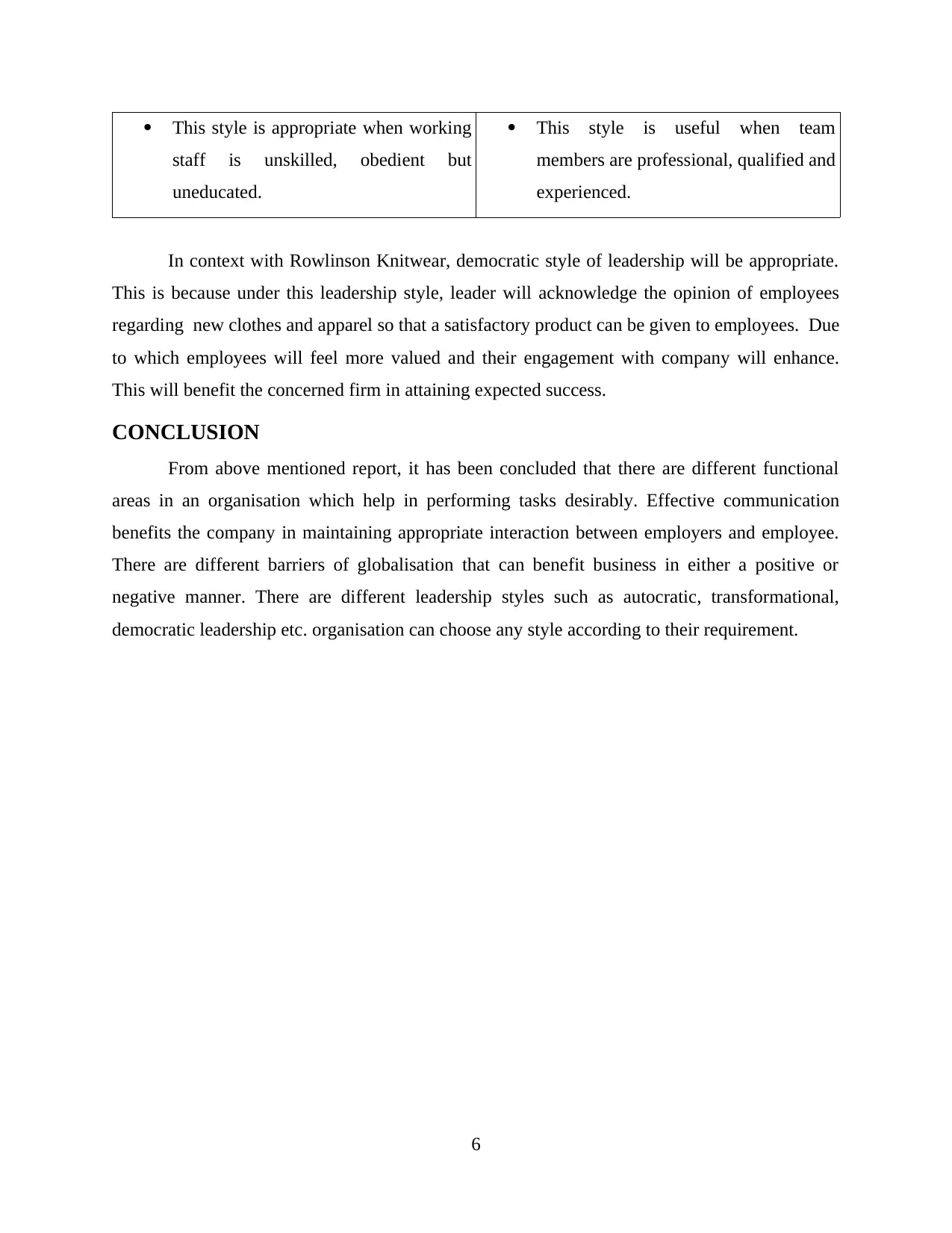
This style is appropriate when working
staff is unskilled, obedient but
uneducated.
This style is useful when team
members are professional, qualified and
experienced.
In context with Rowlinson Knitwear, democratic style of leadership will be appropriate.
This is because under this leadership style, leader will acknowledge the opinion of employees
regarding new clothes and apparel so that a satisfactory product can be given to employees. Due
to which employees will feel more valued and their engagement with company will enhance.
This will benefit the concerned firm in attaining expected success.
CONCLUSION
From above mentioned report, it has been concluded that there are different functional
areas in an organisation which help in performing tasks desirably. Effective communication
benefits the company in maintaining appropriate interaction between employers and employee.
There are different barriers of globalisation that can benefit business in either a positive or
negative manner. There are different leadership styles such as autocratic, transformational,
democratic leadership etc. organisation can choose any style according to their requirement.
6
staff is unskilled, obedient but
uneducated.
This style is useful when team
members are professional, qualified and
experienced.
In context with Rowlinson Knitwear, democratic style of leadership will be appropriate.
This is because under this leadership style, leader will acknowledge the opinion of employees
regarding new clothes and apparel so that a satisfactory product can be given to employees. Due
to which employees will feel more valued and their engagement with company will enhance.
This will benefit the concerned firm in attaining expected success.
CONCLUSION
From above mentioned report, it has been concluded that there are different functional
areas in an organisation which help in performing tasks desirably. Effective communication
benefits the company in maintaining appropriate interaction between employers and employee.
There are different barriers of globalisation that can benefit business in either a positive or
negative manner. There are different leadership styles such as autocratic, transformational,
democratic leadership etc. organisation can choose any style according to their requirement.
6
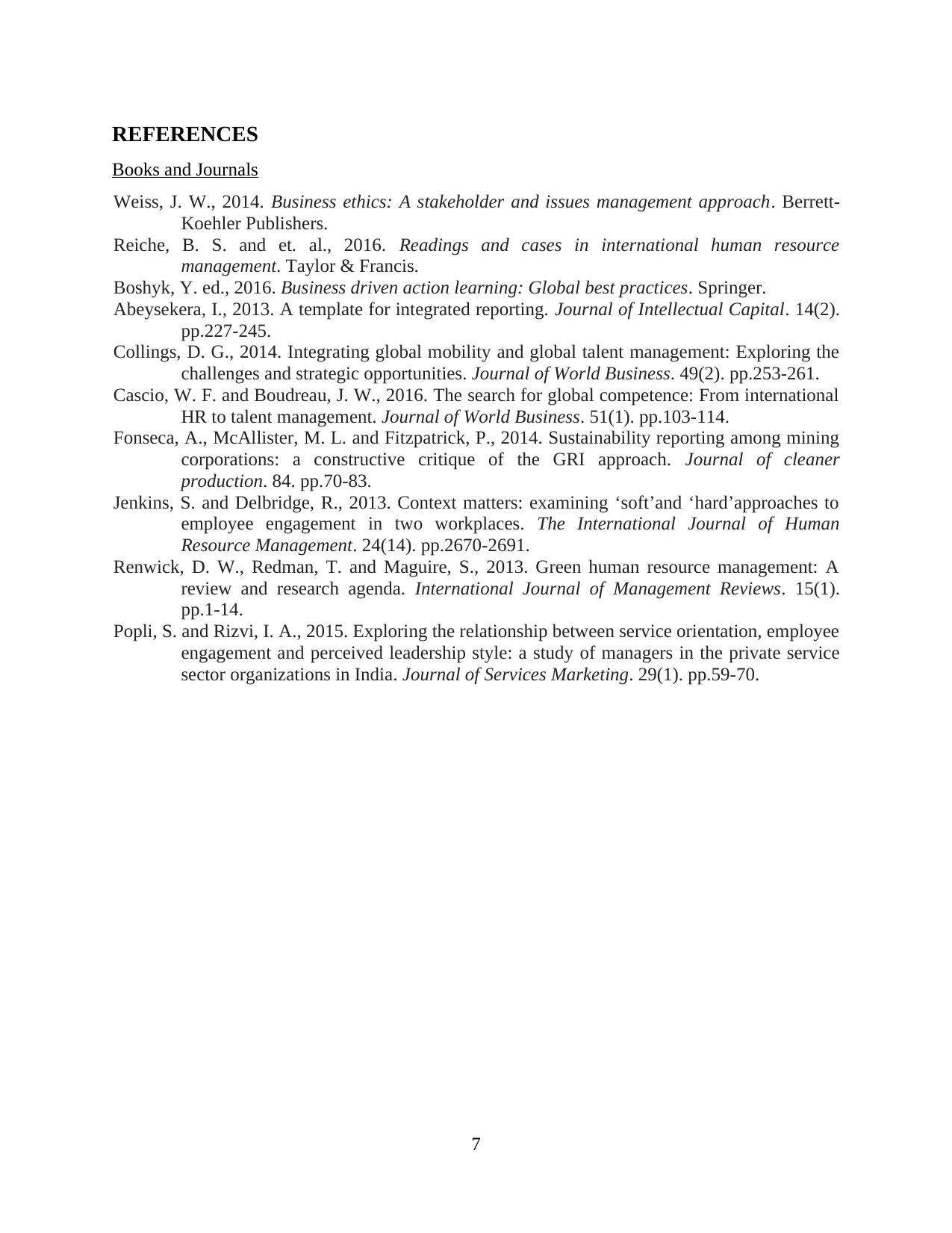
REFERENCES
Books and Journals
Weiss, J. W., 2014. Business ethics: A stakeholder and issues management approach. Berrett-
Koehler Publishers.
Reiche, B. S. and et. al., 2016. Readings and cases in international human resource
management. Taylor & Francis.
Boshyk, Y. ed., 2016. Business driven action learning: Global best practices. Springer.
Abeysekera, I., 2013. A template for integrated reporting. Journal of Intellectual Capital. 14(2).
pp.227-245.
Collings, D. G., 2014. Integrating global mobility and global talent management: Exploring the
challenges and strategic opportunities. Journal of World Business. 49(2). pp.253-261.
Cascio, W. F. and Boudreau, J. W., 2016. The search for global competence: From international
HR to talent management. Journal of World Business. 51(1). pp.103-114.
Fonseca, A., McAllister, M. L. and Fitzpatrick, P., 2014. Sustainability reporting among mining
corporations: a constructive critique of the GRI approach. Journal of cleaner
production. 84. pp.70-83.
Jenkins, S. and Delbridge, R., 2013. Context matters: examining ‘soft’and ‘hard’approaches to
employee engagement in two workplaces. The International Journal of Human
Resource Management. 24(14). pp.2670-2691.
Renwick, D. W., Redman, T. and Maguire, S., 2013. Green human resource management: A
review and research agenda. International Journal of Management Reviews. 15(1).
pp.1-14.
Popli, S. and Rizvi, I. A., 2015. Exploring the relationship between service orientation, employee
engagement and perceived leadership style: a study of managers in the private service
sector organizations in India. Journal of Services Marketing. 29(1). pp.59-70.
7
Books and Journals
Weiss, J. W., 2014. Business ethics: A stakeholder and issues management approach. Berrett-
Koehler Publishers.
Reiche, B. S. and et. al., 2016. Readings and cases in international human resource
management. Taylor & Francis.
Boshyk, Y. ed., 2016. Business driven action learning: Global best practices. Springer.
Abeysekera, I., 2013. A template for integrated reporting. Journal of Intellectual Capital. 14(2).
pp.227-245.
Collings, D. G., 2014. Integrating global mobility and global talent management: Exploring the
challenges and strategic opportunities. Journal of World Business. 49(2). pp.253-261.
Cascio, W. F. and Boudreau, J. W., 2016. The search for global competence: From international
HR to talent management. Journal of World Business. 51(1). pp.103-114.
Fonseca, A., McAllister, M. L. and Fitzpatrick, P., 2014. Sustainability reporting among mining
corporations: a constructive critique of the GRI approach. Journal of cleaner
production. 84. pp.70-83.
Jenkins, S. and Delbridge, R., 2013. Context matters: examining ‘soft’and ‘hard’approaches to
employee engagement in two workplaces. The International Journal of Human
Resource Management. 24(14). pp.2670-2691.
Renwick, D. W., Redman, T. and Maguire, S., 2013. Green human resource management: A
review and research agenda. International Journal of Management Reviews. 15(1).
pp.1-14.
Popli, S. and Rizvi, I. A., 2015. Exploring the relationship between service orientation, employee
engagement and perceived leadership style: a study of managers in the private service
sector organizations in India. Journal of Services Marketing. 29(1). pp.59-70.
7
⊘ This is a preview!⊘
Do you want full access?
Subscribe today to unlock all pages.

Trusted by 1+ million students worldwide
1 out of 9
Related Documents
Your All-in-One AI-Powered Toolkit for Academic Success.
+13062052269
info@desklib.com
Available 24*7 on WhatsApp / Email
![[object Object]](/_next/static/media/star-bottom.7253800d.svg)
Unlock your academic potential
Copyright © 2020–2025 A2Z Services. All Rights Reserved. Developed and managed by ZUCOL.




